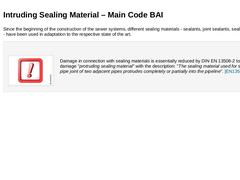
|
Since the beginning of the construction of the sewer systems, different sealing materials - sealants, joint sealants, sealing rings, etc. - have been used in adaptation to the respective state of the art. Important: Damage in connection with sealing materials is essentially reduced by DIN EN 13508-2 to the damage "protruding sealing material" with the description: "The sealing material used for sealing a pipe joint of two adjacent pipes protrudes … |
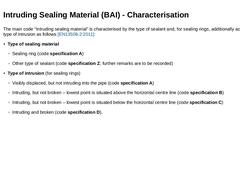
|
The main code “Intruding sealing material” is characterised by the type of sealant and, for sealing rings, additionally according to the type of intrusion as follows [EN13508-2:2011]: |
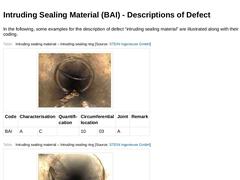
|
In the following, some examples for the description of defect “intruding sealing material” are illustrated along with their respective coding. (Table: Intruding sealing material – Intruding sealing ring) (Table: Intruding sealing material – Intruding sealing ring) (Table: Intruding sealing material – Intruding and broken sealing ring) (Table: Intruding sealing material – Intruding sealing ring with root ingrowth) According to EN 13508-2, the occurring |
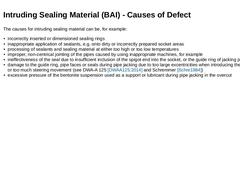
|
The causes for intruding sealing material can be, for example: -
incorrectly inserted or dimensioned sealing rings
-
inappropriate application of sealants, e.g. onto dirty or incorrectly prepared socket areas
-
processing of sealants and sealing material at either too high or too low temperatures
-
improper, non-centrical jointing of the pipes caused by using inappropriate machines, for example
-
ineffectiveness of the seal due to insufficient inclusion …
|
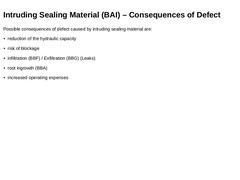
|
Possible consequences of defect caused by intruding sealing material are: -
reduction of the hydraulic capacity
-
risk of blockage
-
infiltration (BBF) / Exfiltration (BBG) (Leaks)
-
root ingrowth (BBA)
-
increased operating expenses
|
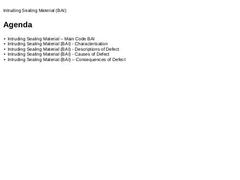
|
|
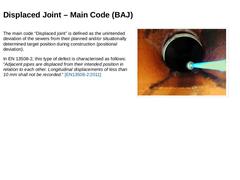
|
The main code “Displaced joint” is defined as the unintended deviation of the sewers from their planned and/or situationally determined target position during construction (positional deviation). In EN 13508-2, this type of defect is characterised as follows: “Adjacent pipes are displaced from their intended position in relation to each other. Longitudinal displacements of less than 10 mm shall not be recorded.” [EN13508-2:2011] (Image: Displaced Joint ) |
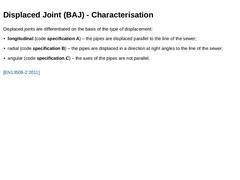
|
Displaced joints are differentiated on the basis of the type of displacement: -
longitudinal (code specification A) – the pipes are displaced parallel to the line of the sewer;
-
radial (code specification B) – the pipes are displaced in a direction at right angles to the line of the sewer;
-
angular (code specification C) – the axes of the pipes are not parallel.
|
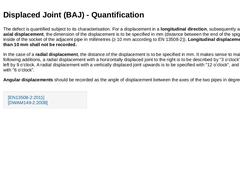
|
The defect is quantified subject to its characterisation. For a displacement in a longitudinal direction, subsequently also called axial displacement, the dimension of the displacement is to be specified in mm (distance between the end of the spigot and the inside of the socket of the adjacent pipe in millimetres (≥ 10 mm according to EN 13508-2)). Longitudinal displacements of less than 10 mm shall not be recorded. In the case of a radial displacement |
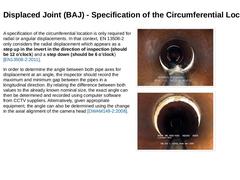
|
A specification of the circumferential location is only required for radial or angular displacements. In that context, EN 13508-2 only considers the radial displacement which appears as a step up in the invert in the direction of inspection (should be 12 o’clock) and a step down (should be 6 o’clock) [EN13508-2:2011]. In order to determine the angle between both pipe axes for displacement at an angle, the inspector should record the maximum and minimum … |
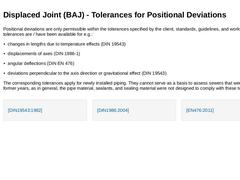
|
Positional deviations are only permissible within the tolerances specified by the client, standards, guidelines, and worksheets. Such tolerances are / have been available for e.g.: -
changes in lengths due to temperature effects (DIN 19543)
-
displacements of axes (DIN 1986-1)
-
angular deflections (DIN EN 476)
-
deviations perpendicular to the axis direction or gravitational effect (DIN 19543)
The corresponding tolerances apply for newly installed piping. … |
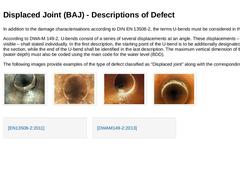
|
In addition to the damage characterisations according to DIN EN 13508-2, the terms U-bends must be considered in this context. According to DWA-M 149-2, U-bends consist of a series of several displacements at an angle. These displacements – as far as visible – shall stated individually. In the first description, the starting point of the U-bend is to be additionally designated as the start of the section, while the end of the U-bend shall be identified … |
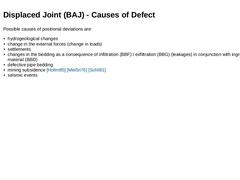
|
Possible causes of positional deviations are: -
hydrogeological changes
-
change in the external forces (change in loads)
-
settlements
-
changes in the bedding as a consequence of infiltration (BBF) / exfiltration (BBG) (leakages) in conjunction with ingress of soil material (BBD)
-
defective pipe bedding
-
mining subsidence [Hollm85] [Meißn76] [Schil81]
-
seismic events
|
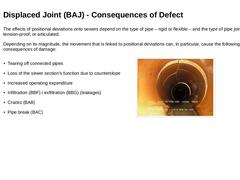
|
The effects of positional deviations onto sewers depend on the type of pipe – rigid or flexible – and the type of pipe joint – rigid, tension-proof, or articulated. Depending on its magnitude, the movement that is linked to positional deviations can, in particular, cause the following consequences of damage: -
Tearing off connected pipes
-
Loss of the sewer section’s function due to counterslope
-
Increased operating expenditure
-
Infiltration (BBF) / …
|
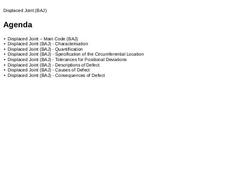
|
|
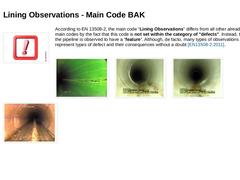
|
Important: According to EN 13508-2, the main code “Lining Observations” differs from all other already mentioned main codes by the fact that this code is not set within the category of "defects". Instead, the lining of the pipeline is observed to have a “feature”. Although, de facto, many types of observations / features represent types of defect and their consequences without a doubt [EN13508-2:2011]. (Image: Lining observations (BAK) - crack (I)) (… |

|
Following [EN13508-2:2011], the defect is supposed to be characterised regarding the nature of the observation with the aid of the code specifications A to N or Z, listed in the table. The table below further specifies the quantification of the respective finding. (Table: Selection chart for the characterisation of the description of damage categorised as “Lining observations (BAK)” in accordance with DWA-M 149-2 and DIN EN 13508-2) |
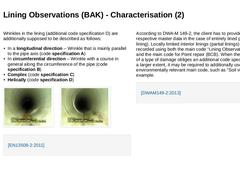
|
Wrinkles in the lining (additional code specification D) are additionally supposed to be described as follows: -
In a longitudinal direction – Wrinkle that is mainly parallel to the pipe axis (code specification A)
-
In circumferential direction – Wrinkle with a course in general along the circumference of the pipe (code specification B)
-
Complex (code specification C)
-
Helically (code specification D)
(Image: Lining observations (BAK) - blistered or … |
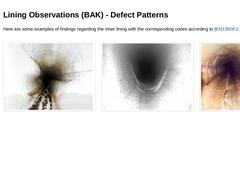
|
Here are some examples of findings regarding the inner lining with the corresponding codes according to [EN13508-2:2011]. (Image: Detection of the inner lining - bulge in the inner lining) (Image: Lining observations – Radial wrinkling in a Troliner (studded HD-PE liner)) (Image: Lining observations – Wrinkling in a longitudinal direction and a reduced cross section for an improperly laid hose liner) |
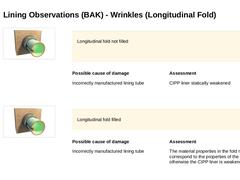
|
(Image: Lining observations – Longitudinal fold not filled) Longitudinal fold not filled Possible cause of damage Incorrectly manufactured lining tube Assessment CIPP liner statically weakened (Image: Lining observations – Longitudinal fold not filled) Possible cause of damage Incorrectly manufactured lining tube Assessment The material properties in the fold must correspond to the properties of the ring, otherwise the CIPP liner is … |
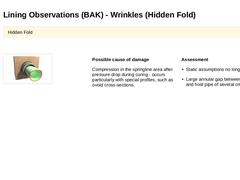
|
(Image: Lining observations – Hidden fold) Possible cause of damage Compression in the springline area after pressure drop during curing - occurs particularly with special profiles, such as ovoid cross-sections. |
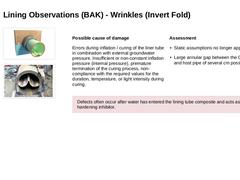
|
(Image: Lining observations – Invert fold) (Image: Lining observations – Invert fold) Possible cause of damage Errors during inflation / curing of the liner tube in combination with external groundwater pressure. Insufficient or non-constant inflation pressure (internal pressure), premature termination of the curing process, non- compliance with the required values for the duration, temperature, or light intensity during curing. |
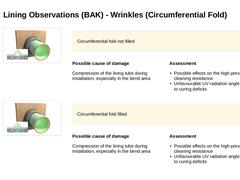
|
(Image: Lining observations – Circumferential fold not filled) Circumferential fold not filled Possible cause of damage Compression of the lining tube during installation, especially in the bend area Assessment -
Possible effects on the high-pressure cleaning resistance
-
Unfavourable UV radiation angle can lead to curing deficits
(Image: Lining observations – Circumferential fold filled) Circumferential fold filled Possible cause of damage Compression of … |
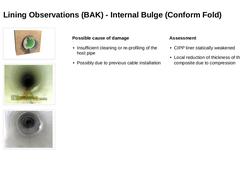
|
(Image: Lining observations – Conform fold) (Image: Lining observations – Conform fold) (Image: Lining observations – Conform fold) |
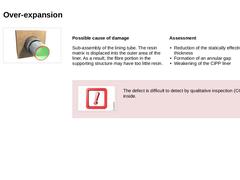
|
(Image: Lining observations – Over-expansion of the CIPP liner) Possible cause of damage Sub-assembly of the lining tube. The resin matrix is displaced into the outer area of the liner. As a result, the fibre portion in the supporting structure may have too little resin. Assessment -
Reduction of the statically effective wall thickness
-
Formation of an annular gap
-
Weakening of the CIPP liner
Important: The defect is difficult to detect by qualitative … |